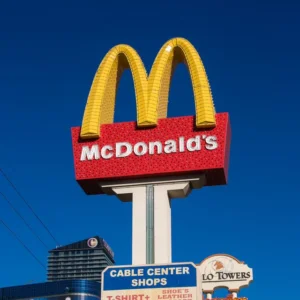McDonald’s Customers Voice Frustration as Prices Continue to Rise
McDonald’s has seen a remarkable 14% surge in revenue, hitting an impressive $6.69 billion, amidst widespread public outcry and growing concerns regarding the escalating prices of fast food. The surge in costs has sparked heated debates among various stakeholders, including customers, industry experts, and economists.

The viral TikTok video was posted by Christopher Olive, a well-known influencer boasting over 400,000 followers. This video sparked the controversy when Olive was charged a hefty sixteen dollars for what he had expected to be a standard “happy meal” at McDonald’s. In the video, Olive expresses shock and dismay at the exorbitant price. This incident served as a wake-up call for many, prompting them to delve deeper into the reasons behind the price hikes.
 Persistent labor shortages and consequent wage hikes are key factors driving the surge in prices. Like many other businesses, McDonald’s has grappled with staffing challenges, prompting the company to raise wages to attract and retain employees. However, these additional labor costs inevitably translate into higher prices for menu items purchased by customers.
Persistent labor shortages and consequent wage hikes are key factors driving the surge in prices. Like many other businesses, McDonald’s has grappled with staffing challenges, prompting the company to raise wages to attract and retain employees. However, these additional labor costs inevitably translate into higher prices for menu items purchased by customers.
Despite facing criticism, McDonald’s has staunchly defended its pricing strategy. While prices have generally risen, the franchise underscores its commitment to offering customers opportunities to save through various specials and discounts accessible via its mobile application. However, for consumers like Anne Arroyo from Ohio, these savings do little to ease dissatisfaction over the perceived disparity between the promised “dollar menu” and the actual prices of menu items.
Arroyo’s opinions resonate with numerous disgruntled McDonald’s customers, fueling accusations of “greedflation.” This term suggests that businesses may exploit inflation fears to maximize profits by raising prices beyond what is truly warranted.
 Despite facing criticism and accusations, McDonald’s continues to see a rise in profitability, partly due to increased menu prices. This highlights ongoing demand for McDonald’s products, albeit potentially straining customers’ financial resources. It also raises concerns about the franchise’s long-term pricing strategy viability and its implications for customers and the fast-food industry as a whole.
Despite facing criticism and accusations, McDonald’s continues to see a rise in profitability, partly due to increased menu prices. This highlights ongoing demand for McDonald’s products, albeit potentially straining customers’ financial resources. It also raises concerns about the franchise’s long-term pricing strategy viability and its implications for customers and the fast-food industry as a whole.



